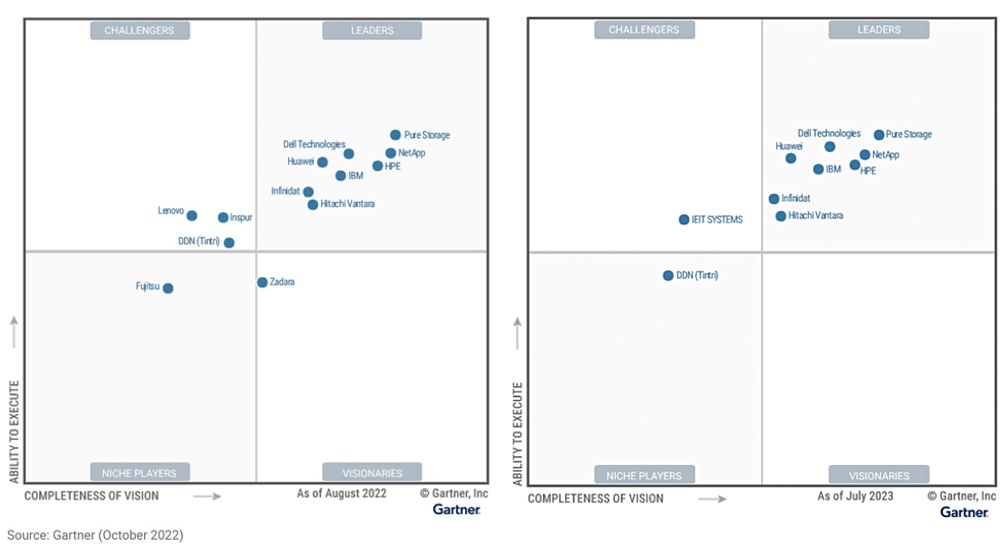The Gartner primary storage magic quadrant has consolidated with eight Leaders – the same as last year – just one Challenger and one Niche player as three suppliers leave the MQ.
Out of the 10 suppliers, eight are leaders in this year’s MQ. As far as the set of suppliers in the leaders’ quadrant are concerned, there is no change in their number from last year or the prior year. As a reminder, the “Magic Quadrant” is a 2D space defined by axes labelled “Ability To Execute” and “Completeness of Vision” split into four squares tagged “Visionaries” and “Niche Players” at the bottom, and “Challengers” and “Leaders” at the top. The best placed vendors are in the top right Leaders box and with a balance between execution ability and vision completion. The nearer they are to the top right corner of that box the better.

There are slight positioning changes in the Leaders’ box. Pure still leads ahead of a tightly packed group composed of NetApp, Dell, HPE, Huawei, and IBM. Infinidat and Hitachi Vantara are both rated slightly lower on completeness of vision than in 2022.
Lenovo and Inspur, who were Challengers last year, have both exited the MQ, and DDN (Tintri), also a Challenger last year, has moved down to the Niche Players box. Gartner’s analysts note three cautions for Tintri:
- Tintri lags the primary storage market leaders in supporting as-a-service consumption plans with SLA guarantees, due to its lack of a product and set of offerings for an on-premises hybrid platform for centralized IT operations.
- Tintri lags market competitors in not offering or supporting ransomware detection capabilities, only recovery from integrated backup support.
- Tintri’s TCE1000 SDS cloud engine lags leading competitive offerings in its breadth of public cloud options that it supports.
IEIT Systems, referred to as Inspur last year, is the sole Challenger now. It is a China-based supplier with, Gartner says, “a broad portfolio of primary storage products, including the NVMe all-flash array HF Series and a new SDS AS13000 ICFS product to address entry-level, midrange and high-end market requirements.” Gartner points out that it lacks a competitive software-defined storage offering for AWS, Azure, and GCP, and lags industry leaders with its workload placement AIOps capabilities.
Last year Fujitsu was a Niche player. It has exited this year’s MQ altogether. Zadara was a Visionary in 2022 but there are now no Visionaries at all.
Zadara supplies a fully managed compute (EC2 compatible), storage (block, file, object), and network system hosted in a customer’s datacenter, a global point-of-presence (POP) network, or in the AWS, Azure, GCP, and Oracle public clouds. It hired a new CEO, Yoram Novick, in April with the previous CEO, co-founder Nelson Nahum, becoming CTO and chairman of the board.
Gartner says: “Fujitsu was unable to meet inclusion criteria, due to its dependency on a third-party storage controller operating system. Lenovo was unable to meet inclusion criteria, due to its dependency on a third-party storage controller operating system. Zadara was unable to meet the minimum revenue inclusion criteria.” The minimum revenue criterion is “$100 million in recognized primary storage billings and or bookings revenue (using GAAP) over the last four quarters as of 31 March 2023, excluding support revenue; or else have generated over $100 million in total annual recurring revenue contract value as of 31 March 2023.”








